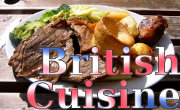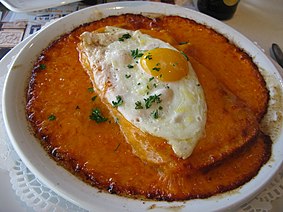welsh cuisine
| This article is part of a series on |
| British cuisine |
|---|
 |
|
Overseas/Fusion cuisine
|
Welsh cuisine is the specific set of cooking traditions and practices associated with the country of Wales. It has influenced, and been influenced by, other British cuisine. Beef and dairy cattle are raised widely. Sheep farming is extensive in the country and lamb is the meat traditionally associated with Welsh cooking, particularly in dishes such as roast lamb with fresh mint sauce. Welsh cooking often includes seafood, especially close to the coast, where fishing culture is strong and fisheries are common. This is exemplified by the use of cockles and laverbread in Welsh cuisine. The vegetable leek, because of its role as the country’s national vegetable, is also used frequently in Welsh cuisine.
Contents |
[edit] Welsh dishes
| Part of a series on the |
| Culture of Wales |
|---|
 |
| History |
| People |
|
| Religion |
| Art |
- Tatws Pum Munud (English: five minute potatoes), a traditional Welsh stew, made with potatoes, vegetables and bacon, and cooked on top of the stove.
- Tatws Popty (English: oven potatoes), a traditional Welsh stew, made with potatoes, vegetables and a joint of meat, and cooked in an oven.
- Teisennau Tatws (English: Potato Cakes), is a potato dish, served as an accompaniment – not a main dish in its own right.
- Welsh rarebit or Welsh rabbit, although now synonymous with Wales, the origins of this dish are unclear and the name may actually be an ironic English reference to Welsh cuisine. The Welsh term for this dish is caws pobi, meaning ‘baked cheese’.
- Bara brith, “speckled bread”, is a sweet bread which originated in Wales. It is traditionally made with raisins, Zante currant, and candied peel.
- Cawl is a Welsh stew with lamb and leeks.
- Roast lamb with laver sauce or with mint sauce
- Shepherd’s pie, a type of lamb meat pie made with mashed potatoes, is often associated with Wales.
- Cockles are very popular in Wales and served in a variety of ways although usually steamed.
- Crempogau are Welsh buttermilk pancakes.
- Faggots are Welsh meatballs made from lamb or pig’s liver, onions and a cereal binder.
- Glamorgan sausage (Welsh: Selsig Morgannwg) is cheese, eggs and breadcrumbs in the shape of a sausage.
- Laverbread, or Bara Lawr in Welsh, is a Welsh seaweed delicacy. The laver is mixed with oatmeal, which is formed into patties and usually fried in bacon fat.
- Welsh cakes also known as bakestones (Welsh: picau ar y maen, picau bach, cacenni cri or teisennau gradell) are small cakes cooked on a bakestone.
- Leek soup (Welsh: Cawl Cennin or Cawl Mamgu (“Granny’s stew”)).
- Lobscows is a popular stew in Holyhead and Anglesey.
- Monkfish, often served with laver, common on the coast.
[edit] Cheese
Cheese has long been a traditional food of Wales, with Welsh Rarebit being a popular national dish by Tudor times, though known then as caws pobi.[1] The best known Welsh cheese is Caerphilly, though many other types exist, including Y Fenni, Tintern and Pantysgawn. Popular brands include Black Bomber made by the Snowdonia Cheese Company and Collier’s Powerful Welsh Cheddar.
[edit] Beverages
Beer is the national drink of Wales.[2] There are a number of Welsh beers and more than 20 vineyards in the country. Most of the vineyards have been started since the 1970s. By contrast, S A Brain and Felinfoel breweries have existed since the late 19th century, based on breweries which were yet older.
[edit] Beer
References to intoxicating preparations of grain and herbs appear in several works by the 6th century Welsh poet Taliesin, particularly the Hanes Taliesin. This preparation, Gwîn a Bragawd, is said to have brought “science, inspiration and immortality”.[3] While King Ine of Wessex, who ruled during the late 7th century, declared that food rent for ten hides of land should include ‘twelve ambers of Welsh ale’ (bragawd).[2] Bragawd, also called braggot, is somewhat between mead and what we today think of as ale.
The Anglo-Saxon Chronicle for 852 records a distinction between “fine ale” and Welsh ale.[4]
Welsh beer is noted as a distinct style as late as 1854, with a recipe made solely from pale malt and hops described in a recipe book of the time.[5]
Wrexham was one of the first places in the UK to brew lager.[6] Homesick German immigrant brothers from Saxony started the process in 1882. While Welsh local historian Deiniol ap Dafydd claims Arthur Guinness used a Welsh recipe, from Llanfairfechan, near Bangor for his stout[7]
[edit] Whisky
Unlike Ireland and Scotland, Wales does not have a long tradition of distilling, with only small cottage industries appearing over the last two centuries. Manufacturing of whisky ceased in Wales in 1910.[8]
In 1998, the Welsh Whisky Company, now known as Penderyn, was formed and whisky production began at Penderyn, Rhondda Cynon Taf in 2000. Penderyn single malt whisky was the first whisky commercially produced in Wales for a century and went on sale in 2004.[9]
[edit] Water
List of brands of Welsh bottled water (spring and mineral)
- Brecon Carreg – Llandeilo, Carmarthenshire.
- Cerist Natural Mineral Water – Dinas Mawddwy, Powys.
- Llanllyr SOURCE – Lampeter, Ceredigion.
- Princes Gate Spring Water – Narberth, Pembrokeshire.
- 3W – Llandrindod Wells, Powys.
- Ty Nant – Llanon, Ceredigion.
Typhoo produce a tea called Glengettie, which is specifically aimed at the Welsh market. The packaging is printed in both Welsh and English.
Murroughs Welsh Brew tea (Paned Gymreig), sold in bilingual packaging, is packed and blended for Wales by Adwell Foods, of Langland, on the Gower Peninsula.[10]
Gaiman, in Patagonia, Argentina is famous for its Welsh tea houses, run by the descendants of Welsh immigrants.[11]
[edit] Wine
List of Welsh vinyards;
- Bryn Celynnog Vineyard – Penarth, South Glamorgan.
- Celtic Country Wines – Llandysul, Ceredigion.
- Cwm Deri Vineyard – Narberth, Pembrokeshire.
- Gelynis Vineyard – Morganstown, Cardiff.
- Glyndwr Vineyard – Cowbridge, Vale of Glamorgan.
- Gwinllan Ffynnon Las Vineyard – Aberaeron, Ceredigion.
- Llanerch Vineyard – Pendoylan, Vale of Glamorgan.
- Parva Farm Vineyard – Tintern, Monmouthshire.
- Sugarloaf Vineyard – Abergavenny, Monmouthshire.
- Wernddu Organics – Pen-Y-Clawdd, Monmouth.[12]
- Worthenbury Wines – Worthenbury, Wrexham.
[edit] Soft drinks
Corona was a carbonated soft drink manufacturer set up in 1897 in the Rhondda, bought by Britvic in the 1980s, the company has since been dissolved. Lurvills Delight was a popular carbonated soft drink in Wales between 1896 and 1910.
[edit] Miscellaneous foods
Breakfast is traditionally an important meal in Wales. A hearty breakfast of eggs and cockles fried with bacon and sausage, served with laverbread, is known as a “traditional” Welsh breakfast.
[edit] See also
[edit] References
- ^ Davies (2008) p.137
- ^ a b Davies (2008) p. 57
- ^ Edward Davies (1809). The Mythology and Rites of the British Druids, Ascertained by National Documents. J. Booth. pp. 217–220.
- ^ “that Wulfred should give the land of Sleaford to Meohamsted, and should send each year into the monastery sixty loads of wood, twelve loads of coal, six loads of peat, two tuns full of fine ale, two neats’ carcases, six hundred loaves, and ten kilderkins of Welsh ale; one horse also each year, and thirty shillings, and one night’s entertainment.”
- ^ Arnold James Cooley (1854). A Cyclopaedia of Six Thousand Practical Receipts, and Collateral Information. pp. 44–45.
- ^ Brewers & Boozers Tour on Wrexham County Borough Council’s website
- ^ Cook, Jonathan (12 March 2000). “Wales claims Guinness as its invention”. The Guardian (London). http://www.guardian.co.uk/uk/2000/mar/12/jonathancook.theobserver.
- ^ Davies (2008) pp.947-948
- ^ “Rebirth of Welsh whisky spirit”. BBC News. 8 May 2008. http://news.bbc.co.uk/1/hi/business/7374969.stm.
- ^ “Murroughs Welsh Brew Tea”. Adwell Foods Ltd. 2010. http://www.welshbrewtea.com/content/about.htm. Retrieved 23 October 2010.
- ^ “Taking Tea and Tortes With the Welsh In Distant Patagonia”. The New York Times. 3 April 2005. http://query.nytimes.com/gst/fullpage.html?res=9A03E4D7153FF930A35757C0A9639C8B63&sec=travel&spon=&pagewanted=2.
- ^ Wernddu Organics, wines.
[edit] Bibliography
- Davies, John; Jenkins, Nigel (2008). The Welsh Academy Encyclopaedia of Wales. Cardiff: University of Wales Press. ISBN 978-0-7083-1953-6.
[edit] External links
- Welsh Agricultural Statistics from the Welsh Assembly.
- Welsh Food
- Culture UK Welsh Food
- Article on Welsh food in Spectator Scoff
|
|||||||||||
|
|||||||||||||||||||||||||||||||||||||||||||
This article uses material from the Wikipedia article welsh cuisine, which is released under the Creative Commons Attribution-Share-Alike License 3.0.


